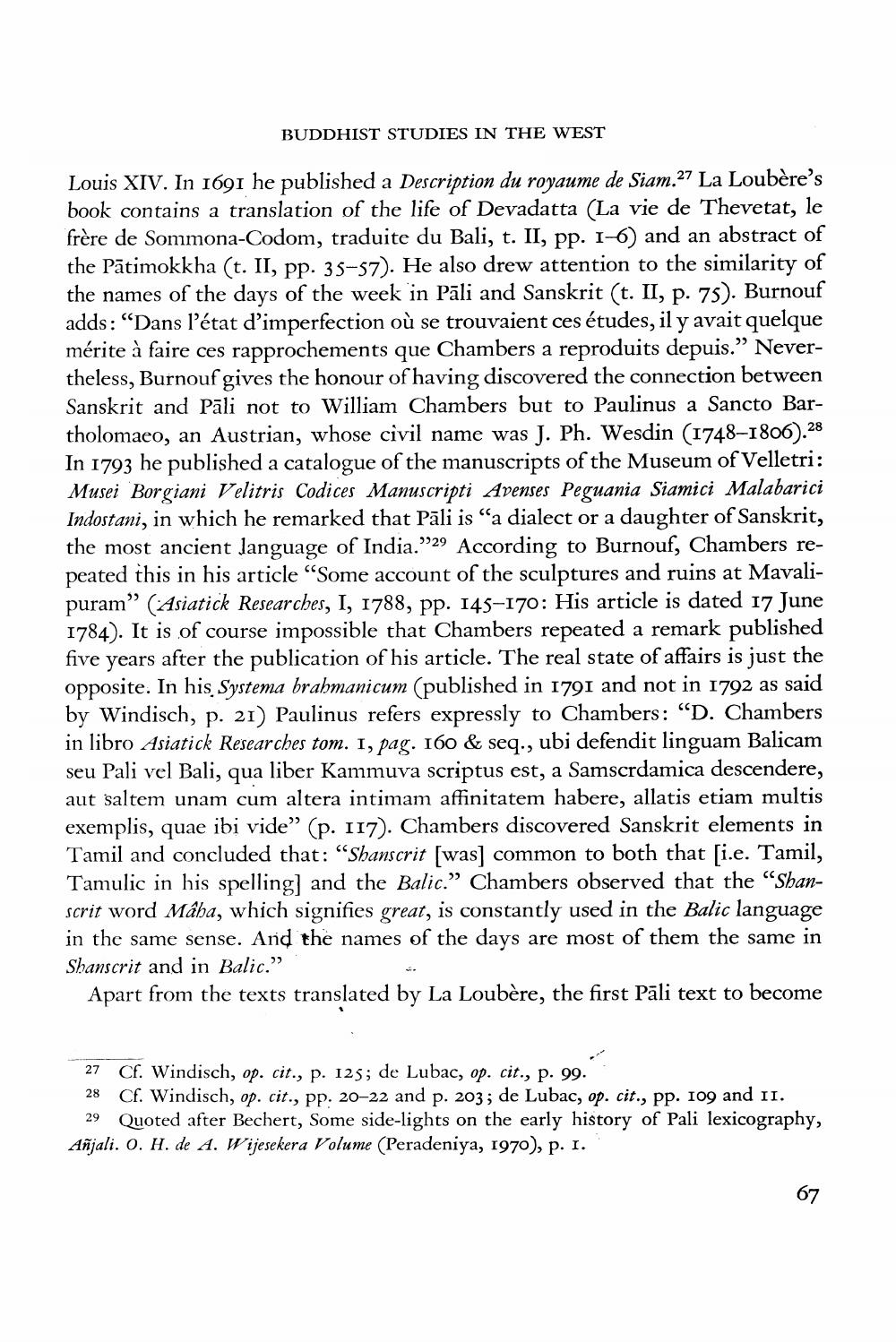________________
Louis XIV. In 1691 he published a Description du royaume de Siam.27 La Loubère's book contains a translation of the life of Devadatta (La vie de Thevetat, le frère de Sommona-Codom, traduite du Bali, t. II, pp. 1-6) and an abstract of the Patimokkha (t. II, pp. 35-57). He also drew attention to the similarity of the names of the days of the week in Pāli and Sanskrit (t. II, p. 75). Burnouf adds: "Dans l'état d'imperfection où se trouvaient ces études, il y avait quelque mérite à faire ces rapprochements que Chambers a reproduits depuis." Nevertheless, Burnouf gives the honour of having discovered the connection between Sanskrit and Pali not to William Chambers but to Paulinus a Sancto Bartholomaeo, an Austrian, whose civil name was J. Ph. Wesdin (1748-1806).28 In 1793 he published a catalogue of the manuscripts of the Museum of Velletri: Musei Borgiani Velitris Codices Manuscripti Avenses Peguania Siamici Malabarici Indostani, in which he remarked that Pāli is "a dialect or a daughter of Sanskrit, the most ancient language of India."29 According to Burnouf, Chambers repeated this in his article "Some account of the sculptures and ruins at Mavalipuram" (Asiatick Researches, I, 1788, pp. 145-170: His article is dated 17 June 1784). It is of course impossible that Chambers repeated a remark published five years after the publication of his article. The real state of affairs is just the opposite. In his Systema brahmanicum (published in 1791 and not in 1792 as said by Windisch, p. 21) Paulinus refers expressly to Chambers: "D. Chambers in libro Asiatick Researches tom. 1, pag. 160 & seq., ubi defendit linguam Balicam seu Pali vel Bali, qua liber Kammuva scriptus est, a Samscrdamica descendere, aut saltem unam cum altera intimam affinitatem habere, allatis etiam multis exemplis, quae ibi vide" (p. 117). Chambers discovered Sanskrit elements in Tamil and concluded that: "Shanscrit [was] common to both that [i.e. Tamil, Tamulic in his spelling] and the Balic." Chambers observed that the "Shanscrit word Maha, which signifies great, is constantly used in the Balic language in the same sense. And the names of the days are most of them the same in Shanscrit and in Balic."
Apart from the texts translated by La Loubère, the first Pāli text to become
BUDDHIST STUDIES IN THE WEST
27
Cf. Windisch, op. cit., p. 125; de Lubac, op. cit., p. 99.
29
Cf. Windisch, op. cit., pp. 20-22 and p. 203; de Lubac, op. cit., pp. 109 and II. Quoted after Bechert, Some side-lights on the early history of Pali lexicography, Añjali. O. H. de A. Wijesekera Volume (Peradeniya, 1970), p. 1.
28
67




